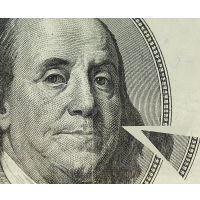Senate Pulls a Fast One on Banks by Trying to Eliminate 102-Year-Old Freebie
 (graphic: 9george, Getty Images)
(graphic: 9george, Getty Images)
Banking lobbyists are furiously fighting a proposed and unexpected cut in revenues that the industry has received for more than a century.
Included in Senate legislation to fund highways is a provision to greatly reduce the dividend that the Federal Reserve pays to banks that participate in the Fed system.
The payout, which is 6%, has been around since Congress authorized the Federal Reserve Act of 1913. More than 2,900 banks have purchased stock (equal to 6% of each bank’s total capital and surplus) in the central bank that allows them to participate in the system. For the banks, it’s a win-win investment because it is subsidized by the government in the form of the annually-paid 6% dividend. It originally came about as a marketing ploy to bring banks on board, making up for the fact that the stock can’t increase in value, nor can be traded or sold.
In 2012, the Fed handed $1.637 billion in dividends to banks, most of it tax-free, according to The New Republic. It’s “a risk-free entitlement program,” wrote the magazine’s David Dayen. “It’s one of the many unknown ways the Fed extends special benefits to Wall Street.”
But senators are always looking for ways to boost government revenues to help pay for their legislation. They have now turned to the banks’ 6% dividend for a healthy source of funding. Without any advance notice to the banking industry, they included a provision in the highway bill—which lawmakers are hoping to pass before funding evaporates at month’s end—that would reduce the dividend to 1.5% for banks that hold more than $1 billion in assets.
The reduction would reap about $17 billion for the government.
Lobbyists say they were blindsided by the idea. Paul Merski with the Independent Community Bankers of America told The Hill: “There was no study of the issue, no hearings, no consultation with the Federal Reserve itself.”
The industry is mobilizing its members to encourage senators to scrap the plan. They’re getting help from Senate Banking Committee Chairman Richard Shelby (R-Alabama), who opposes the provision.
James Ballentine of the American Bankers Association has also denounced the provision, saying that it doesn’t belong in highway legislation. Or is the Senate sending a subtle message? Fed Chairwoman Janet Yellen worries that banks may indeed hit the highway over this dividend cut and opt out of the Fed.
-Danny Biederman, Noel Brinkerhoff
To Learn More:
Banks Revolt Over Plan To Kill $17B Fed Payout (by Peter Schroeder, The Hill)
This Is the Fed's Most Brazen and Least Known Handout to Private Banks (by David Dayen, New Republic)
- Top Stories
- Unusual News
- Where is the Money Going?
- Controversies
- U.S. and the World
- Appointments and Resignations
- Latest News
- Donald Trump Has a Mental Health Problem and It Has a Name
- Trump Goes on Renaming Frenzy
- Trump Deports JD Vance and His Wife
- Trump Offers to Return Alaska to Russia
- Musk and Trump Fire Members of Congress






Comments